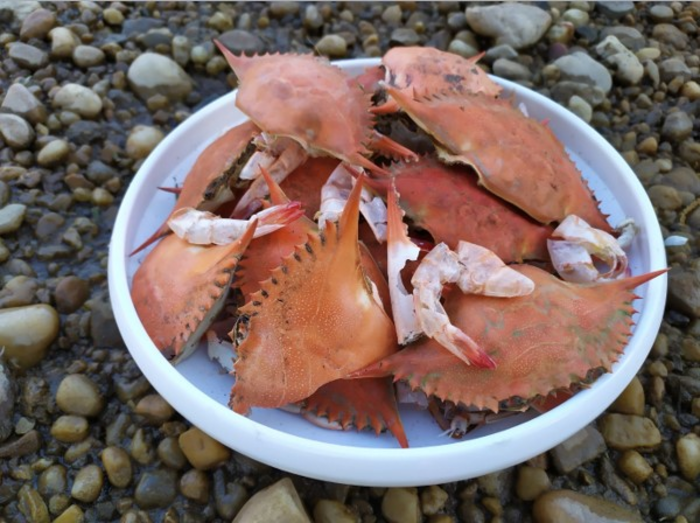Scientists create an eco-friendly battery made from an unexpected source — crab shells
Accelerating demand for renewable energy and electric vehicles is sparking a high demand for the batteries that store generated energy

[Sept 25, 2022: Kelcie Walther, Cell Press]
Crab and shrimp shells are an abundant source of chitin (Credit: Liangbing Hu)
Accelerating demand for renewable energy and electric vehicles is sparking a high demand for the batteries that store generated energy and power engines. But the batteries behind these sustainability solutions aren’t always sustainable themselves.
In a paper published in the journal Matter, scientists create a zinc battery with a biodegradable electrolyte from an unexpected source—crab shells.
“Vast quantities of batteries are being produced and consumed, raising the possibility of environmental problems,” says lead author Liangbing Hu, director of the University of Maryland’s Center for Materials Innovation. “For example, polypropylene and polycarbonate separators, which are widely used in Lithium-ion batteries, take hundreds or thousands of years to degrade and add to environmental burden.”
Batteries use an electrolyte to shuttle ions back and forth between positively and negatively charged terminals. An electrolyte can be a liquid, paste, or gel, and many batteries use flammable or corrosive chemicals for this function.
Related Stories
This new battery, which could store power from large-scale wind and solar sources, uses a gel electrolyte made from a biological material called chitosan.
In this diagram, you can see how the chitosan gets converted to a battery and eventually biodegrades. (Credit: CNET)
“Chitosan is a derivative product of chitin. Chitin has a lot of sources, including the cell walls of fungi, the exoskeletons of crustaceans, and squid pens,” says Hu. “The most abundant source of chitosan is the exoskeletons of crustaceans, including crabs, shrimps and lobsters, which can be easily obtained from seafood waste. You can find it on your table.”
A biodegradable electrolyte means that about two thirds of the battery could be broken down by microbes—this chitosan electrolyte broke down completely within five months. This leaves behind the metal component, in this case zinc, rather than lead or lithium, which could be recycled.
“Zinc is more abundant in earth’s crust than lithium,” says Hu. “Generally speaking, well-developed zinc batteries are cheaper and safer.” This zinc and chitosan battery has an energy efficiency of 99.7% after 1000 battery cycles, making it a viable option for storing energy generated by wind and solar for transfer to power grids.
The chitosan-Zn electrolyte exhibits high mechanical strength, Zn2+ conductivity, and water bonding capability, which enable a desirable Zn-deposition morphology of parallel hexagonal Zn platelets. Using the chitosan-Zn electrolyte, the Zn anode shows exceptional cycling stability and rate performance, with a high Coulombic efficiency of 99.7% and >1,000 cycles at 50 mA cm−2.
The full batteries show excellent high-rate performance (up to 20C, 40 mA cm−2) and long-term cycling stability (>400 cycles at 2C). Furthermore, the chitosan-Zn electrolyte is non-flammable and biodegradable, making the proposed Zn-metal battery appealing in terms of safety and sustainability, demonstrating the promise of sustainable biomaterials for green and efficient energy-storage systems.
Hu and his team hope to continue working on making batteries even more environmentally friendly, including the manufacturing process. “In the future, I hope all components in batteries are biodegradable,” says Hu. “Not only the material itself but also the fabrication process of biomaterials.”
Note: Materials provided above by Cell Press. Content may be edited for style and length.
Like these kind of feel good stories? Get the Brighter Side of News' newsletter.
Joshua Shavit
Science & Technology Writer | AI and Robotics Reporter
Joshua Shavit is a Los Angeles-based science and technology writer with a passion for exploring the breakthroughs shaping the future. As a contributor to The Brighter Side of News, he focuses on positive and transformative advancements in AI, technology, physics, engineering, robotics and space science. Joshua is currently working towards a Bachelor of Science in Business Administration at the University of California, Berkeley. He combines his academic background with a talent for storytelling, making complex scientific discoveries engaging and accessible. His work highlights the innovators behind the ideas, bringing readers closer to the people driving progress.



